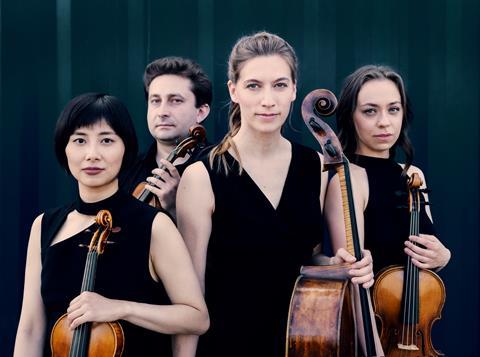Violist Lilya Tymchyshyn outlines the idea behind the quartet’s debut recording - an album comprising of first string quartets by Beethoven, Widmann and Brahms

Discover more Featured Stories like this in The Strad Playing Hub
A debut CD: a scary but exciting concept for any artist. What do we pick, what represents us, who are we?
Our journey with Beethoven began unusually, at the start of 2021 when, faced with another lockdown full of cancelled concerts, we put our heads together to think of a creative project.
’Guys, I have an idea,’ said our cellist Bettina when we met just after the new year. ’Let’s take this whole year to learn all of the Beethoven quartets.’ We all stared at her. ’There are 16 quartets in total. That means we have, give or take, about two weeks for each quartet. Then we (hopefully) play them all in a series of concerts at the end of the year.’
’It’s impossible.’ That was the response we were met with when we told colleagues from other quartets of our new plan. ’You can’t learn a Razumovsky in two weeks.’ ’Das geht nicht.’
It turns out they were right. After several weeks, stuck on a quartet each from the early, middle and late period and unwilling to move on, we decided to put the project on hold. Instead, we somehow became more and more fascinated with Grosse Fuge op.133, spending long hours taking out each dissonance, which created eerily beautiful chorales. Indeed, the longer we worked on this extraordinary piece, the less aggressive and discordant it seemed to us. So we embarked on a new project, eventually ending up producing a recording and music video of this late work.
After the great success of the Fuge, we decided to go back to the very first of Beethoven’s quartets - to op.18 no.1. A fundamentally different piece, we became just as fond of exploring the earliest of the composer’s quartets, but for very different reasons. Perhaps an effect of the early years of founding a string quartet, a certain empathy began to grow between us and the composer - just as we were discovering ourselves as a group, a young Beethoven was finding his own voice.
Beethoven was in his mid-20s when he moved to Vienna, a city which was in political and social turmoil due to the Russo-Turkish War. Composers began to write for smaller chamber ensembles, as many theatres and orchestras endorsed by the aristocracy were forced to close. Beethoven was living at the palace of his first patron Prince Carl Lichnowsky, where he met Ignaz Schuppanzigh, leader of the Schuppanzigh Quartet. The quartet, founded by the prince, premiered many of Beethoven’s new string quartets. The ability of all four of these proficient musicians quickly became very clear to us, as this first quartet op. 18 was by no means easier to learn than the more notoriously difficult Grosse Fuge: lots of open passages, fiddly articulations and, to top it off, every string quartet’s favourite key: F Major. Nevertheless we persevered, and the deeper we delved into the piece, the fonder we grew of it.
The same could be said for Jörg Widmann’s first string quartet which, in contrast to our Beethoven projects, we learnt rather hastily, for the Heidelberger Frühling Festival (incidentally also a lockdown project). Working personally with the composer on his quartet during the festival made us raise the question: should our approach to rehearsing and performing music be any different just because the piece is contemporary?
’Music. Not modern music,’ said Widmann during our masterclass. This perspective, plus the composer’s own passion for music and his knowledge of the thoughts behind his own written notes inspired us to gain a deeper understanding of his music, after which we performed the quartet several times.
It was not without knowledge of the difficulties that lay ahead, however, that Widmann embarked on his journey of writing string quartets. The composer, who spoke to us of the ’burden of writing a quartet after all the greats - Haydn, Beethoven, Mozart, Schubert,’ was scarcely older than Beethoven at the time of the composition of the op.18 quartets. ’That’s why I decided to transform the struggle of beginning [a piece] into a subject itself.’ The piece begins with a grand gesture from the viola who, instead of playing a note, ends up stuck on the string. ’Imagine, this happens to you in concert - it would be the worst possible situation!’ said Widmann.
It quickly became apparent to us that with the idea of embarking upon the ’first’ of any project, every artist is forced to recognise the enormity of the task ahead of them. When it came to picking the repertoire for our debut CD, it was therefore surprisingly easy to then pick the third and last piece: Brahms’ second string quartet - one of the very first pieces which we played together, and a work which has since established itself as a firm favourite within the group.
Another composer who struggled under the shadow of Beethoven, especially in his younger years, Johannes Brahms was his own worst critic. With a habit of writing far more works than he published, and despite Robert Schumann’s legendary article about Brahms titled Neue Bahnen, it wasn’t until the composer wrote and destroyed around 20 quartets that he finally published his two string quartets op.51.
Entirely different from both Beethoven and Widmann, the orchestral quality of the quartet op.51, no.2 required a completely different approach. Thick textures, multiple layers of melody and counterpoint and a symphonic length, it took much patience and care to peel back the layers and put them back together - perhaps something which the composer demands, after the painstaking process of living up to his own expectations.
Ultimately, for our debut album, this collection of ’firsts’ seemed to resonate with us the most. Whether it’s a very first composition, album or even blog article - isn’t it better, after all, to share the burden of a debut, than to shoulder it alone?
The Malion Quartet’s album of works by Beethoven, Widmann and Brahms is out now on Kaleidos. Watch the album trailer here:
Read: Masterclass: Beethoven Grosse Fuge op.133 (part two)
Read: Double Acts: Carolin and Jörg Widmann
Read: Book review: Beethoven: The String Quartets
Read more Featured Stories like this in The Strad Playing Hub
The number one source for playing and teaching books, guides, CDs, calendars and back issues of the magazine.
In The Best of Technique you’ll discover the top playing tips of the world’s leading string players and teachers. It’s packed full of exercises for students, plus examples from the standard repertoire to show you how to integrate the technique into your playing.
The Strad’s Masterclass series brings together the finest string players with some of the greatest string works ever written. Always one of our most popular sections, Masterclass has been an invaluable aid to aspiring soloists, chamber musicians and string teachers since the 1990s.
American collector David L. Fulton amassed one of the 20th century’s finest collections of stringed instruments. This year’s calendar pays tribute to some of these priceless treasures, including Yehudi Menuhin’s celebrated ‘Lord Wilton’ Guarneri, the Carlo Bergonzi once played by Fritz Kreisler, and four instruments by Antonio Stradivari.






































No comments yet